A small guide to supplements: What you need to know
- Disclaimer
- Introduction: Motivaton of this blog
- Anti-aging Supplements
- Enzyme
- Minerals, Vitamins & Fatty Acids
- Suggest Doses, Summary and Concerns
Disclaimer
The information presented on the blog is ONLY intended for knowledge sharing and understanding how supplements work, it is NOT intended as medical advice or as a substitute for medical treatment. You should always consult with your physician or other health care professional before taking any medication or nutritional, herbal or homeopathic supplement.
Introduction: Motivation of this blog
Last week, I had a thought-provoking discussion with my colleagues. The topic of our conversation? Supplements. What intrigued me was that, just like many of my peers, I too have ventured into the world of supplements because of David Sinclair and various of health-related podcasts like Huberman lab. While the reasons taking supplements is easy for me: looking to combat inflammation. For my colleague, this could be boost performance when working out.
A pill that promises health improvements, anti-aging effects, but to be honest I had very limited knowledge of those small pills I’m taking, I yearn for comprehension.What exactly are these supplements composed of at a molecular level? How do these minuscule pills exert their influence within our bodies biologically? Moreover, is there an optimal approach to taking these supplements to maximize their potential benefits for our health and well-being?
Over the past few days, I’ve immersed myself into articles, research papers, and scientific literature. My aim was clear: to understand these tiny capsules that promise health. In the sections to come, I included 10 different supplements and introduced them each from the very essence of these their chemical identities, their categorizations, their mechanisms of action with the academic evidence. In the end a suggest dose for those supplements was given.
Anti-aging Supplements
Resveratrol
Resveratrol (RV) is a potent polyphenolic compound found in a variety of fruits and vegetables, including grapes, skin of peanuts, mulberries, blueberries, bilberries, soybeans, pomegranates, cranberries, soy, dark chocolate, pistachios. It possesses a distinct chemical structure, primarily composed of two aromatic rings connected by a methylene bridge. Biologically when you take resveratorl, it is rapidly metabolized by phase II enzymes in the intestine and liver. The RV’s low solubility(< 0.05mg/ml) in water is caused by its enzymatic structure, which might affect its consumption.[1]

Resveratrol occurs naturally in two forms: trans and cis isomers, with the trans-isomer being the more commonly associated with health benefits. It is typically a white powder extracted using methanol, characterized by a melting point between 253°C and 255°C, and has a relatively low molecular weight of 228.25.[1] While trans-resveratrol is the form primarily studied for its potential health advantages, cis-resveratrol is less prevalent and is typically produced synthetically rather than being the predominant form found in natural sources. The variation in the spatial arrangement of atoms around the double bond results in differences in the chemical and biological properties of these two isomers. Trans-resveratrol is generally considered the more biologically active and bioavailable form, making it the focal point of most research on the potential health benefits of resveratrol.
Mechanisms of action
It has been discovered that RV has many potential health benefits like antioxidant , cardioprotective, neurological, anti-inflammatory, antiplatelet, blood glucose-lowering, and anticancer activities.[1] In another famous experiments in nonhuman primates carried out by Laboratory of Cardiovascular Science, resveratrol has been found to prevent high fat/sucrose (HFS) diet-induced central arterial wall inflammation and stiffening.[2] Below is a simplified summary of its actions:
-
SIRT1/3 Activation: Resveratrol activates SIRT1 and SIRT3 enzymes (SIRT1 and SIRT3 is one of Sirtuin, which are types of proteins involved in metabolic regulation, inflammation), Sirt1 has been implicated in many vital processes, such as DNA repair, cell survival, gluconeogenesis, muscle cell differentiation, cell-cycle regulation, lipid metabolism, fat mobilization and insulin sensitivity. [3]
-
Neuroprotective Effects: It reduces endoplasmic reticulum (ER) stress, inhibits carbonyl protein activity, and supports factors associated with brain health.
-
Cardiometabolic Benefits: Resveratrol improves mitochondrial (The mitochondria are like little workers in a factory. They take the food you eat, use the oxygen you breathe, and create energy for your body) respiratory activity in the heart, increases adenosine monophosphate kinase (p-AMPK) levels (AMPK acts as a sensor of cellular energy status and helps regulate various metabolic processes to ensure the cell has enough energy to function), and boosts SOD2 (a family of enzymes that play a crucial role in protecting cells from damage caused by free radicals) levels, promoting cardiovascular health.
-
Inflammation Regulation: Resveratrol reduces inflammatory parameters, including interleukin-6 IL-6 (IL-6 involved in promoting inflammation, regulating immune cell activity) and Tumor Necrosis Factor-Alpha TNF-α, which plays a significant role in managing oxidative stress.
-
Anti-Cancer Properties: Resveratrol inhibits the production of NADPH oxidase NOX and myeloperoxidase, showing potential anti-cancer effects.
-
Neurological Health: Resveratrol inhibits Nitric oxide synthase iNOS production, protects against lipid peroxidation, and has potential therapeutic effects for Alzheimer’s disease (AD) by promoting amyloid precursor protein cleavage and overcoming oxidative stress.
-
Reproductive System Benefits: Resveratrol improves sperm mobility, increases zinc concentration, and counteracts prooxidative effects in the reproductive system.
-
Intestinal Health: Resveratrol reduces markers like IL-8, Vascular Endothelial Growth Factor VEGF (VEGF’s normal function is to create new blood vessels, but overexpression of VEGF can cause vascular disease), and Reactive oxygen species ROS (ROS are like energetic troublemakers in your body that, when there are too many of them, can create a bit of chaos and cause damage to your cells), indicating a role in managing intestinal disorders. [4]
The figure below shows the general benefits of resveratrol.
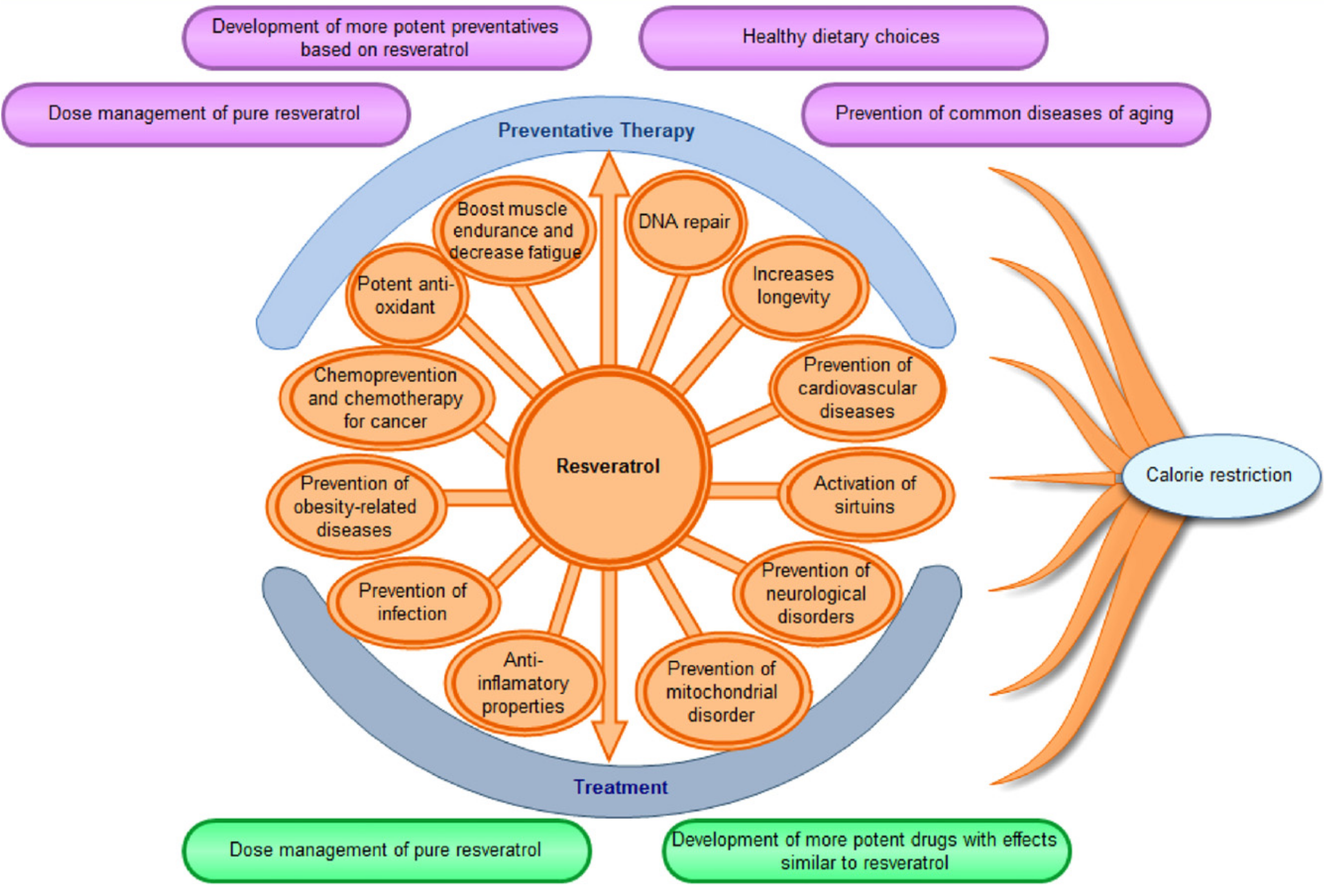
NMN
Nicotinamide Mononucleotide (NMN). In humans, several enzymes use NMN to generate nicotinamide adenine dinucleotide (NADH). (NAD+ (Nicotinamide Adenine Dinucleotide) is a crucial coenzyme in cells that plays a fundamental role in various biological processes, you can think of it as coal for energy production, NAD+ was found gradually declining during aging.[6]) NMN can be found in fruits and vegetables such as broccoli, cabbage, cucumber and avocado at a concentration of about 1 mg per 100g. In mammals most NMN is synthesized from vitamin B3 in the form of nicotinamide. [5]
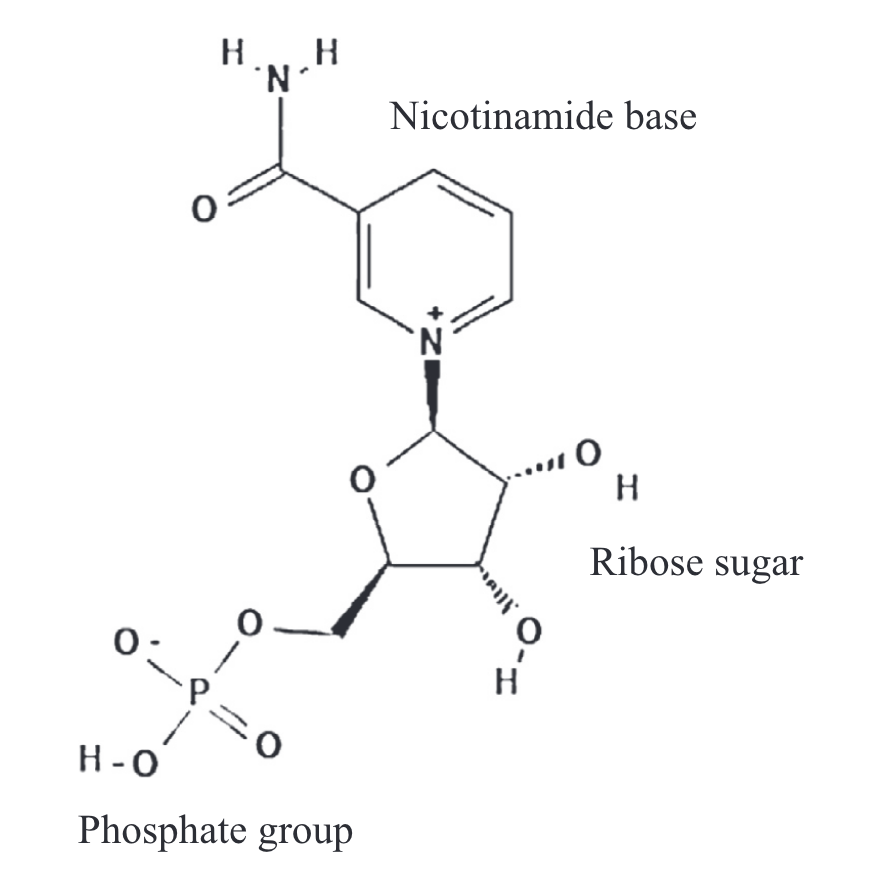
NMN consists of three main components: a nicotinamide group, a ribose sugar, and a phosphate group. The nicotinamide group is connected to the ribose unit, and the phosphate group is attached to the ribose, forming the complete NMN molecule. In the human body, it can be found in placenta tissue and body fluids such as blood and urine. [7]
Mechanisms of action
NAD+ Decline During Aging:
Aging is naturally associated with a decline in NAD+ levels. Enzymes like sirtuins,CD38/CD157, PARP, TNKS, and BST contribute to NAD+ consumption during aging. [7] Chronic inflammation and oxidative stress hinder NAD+ biosynthesis. Reduced NAD+ levels lead to interruptions in cellular communication and mitochondrial dysfunction, contributing to age-related complications.
Why NMN Could Work as a Solution:
NMN (Nicotinamide Mononucleotide) is an intermediate compound in the NAD+ biosynthesis (simple compounds are modified, converted into other compounds) pathway. Administering NMN can compensate for the decline in NAD+ levels during aging. NMN supplementation may activate SIRT1, a protein associated with anti-aging effects. Studies suggest NMN as a potential solution to restore NAD+ levels and counteract aging effects. The effect could be summarized by the figure [7] shown below
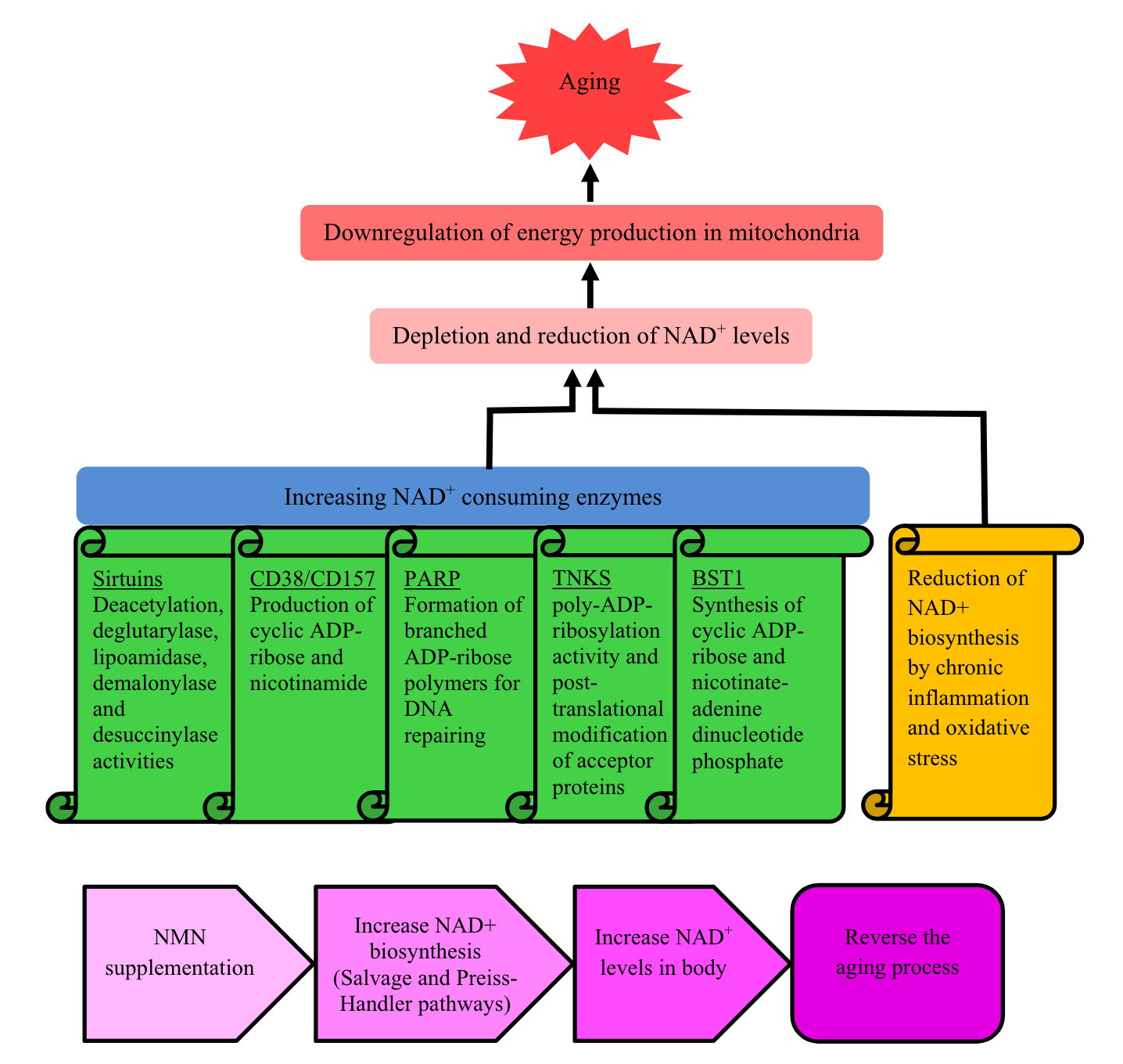
Ubiquinol
The term “ubiquinol” derives from “ubiquitous,” signifying its widespread presence. Ubiquinol is an electron-rich (reduced) form of coenzyme Q (ubiquinone), aka CoQ10. In 1957, Professor Frederick Crane and colleagues discovered CoQ10 from beef heart mitochondria at the University of Wisconsin-Madison Enzyme Institute.6 R.A. Morton, from the United Kingdom, isolated the compound in rat liver just after Dr. Crane’s discovery. It was Morton who named the compound ubiquinone, meaning ubiquitous quinone or one that “exists everywhere.”. In 1962, Peter D. Mitchell, PhD from University of Edinburgh determined how CoQ10 produces energy at the cellular level and in 1978 he was awarded the Nobel Prize for chemistry based on his discovery. Q10 normally could be found in Fish, Calf’s Liver (and other organ meats), Germ portion of whole grains in nature. [8]
CoQ10, also known as ubiquinone, is a necessary component of cell respiration and ATP production. Ubiquinone is a fat soluble substance used to form ubiquinol, the fully reduced form of ubiquinone and potent antioxidant. [8]
Chemical Structure of CoQ10: The most common form in humans is Coenzyme Q10 (CoQ10 or ubiquinone-10). CoQ10 is a 1,4-benzoquinone, where the “Q” refers to the quinone chemical group, and “10” signifies the number of isoprenyl chemical subunits in its tail. (Ubiquinone Tail Variability: In natural ubiquinones, there can be from six to ten subunits in the tail. The specific variant, ubiquinone-10, is predominantly found in humans.)

Mechanisms of action
Role in Energy Production: CoQ10 is a family of fat-soluble substances, resembling vitamins, and is present in all respiring eukaryotic cells, primarily in the mitochondria.
Mitochondrial Function: As a vital component of the electron transport chain, CoQ10 participates in aerobic cellular respiration, a process that generates energy in the form of ATP.
Energy Generation: A substantial 95% of the human body’s energy is generated through aerobic cellular respiration, highlighting the significance of CoQ10.
Organ-Specific Concentrations: Organs with high energy demands, such as the heart, liver, and kidney, exhibit the highest concentrations of CoQ10, emphasizing its critical role in meeting the energy requirements of these vital organs.
The effect of Ubiquinol is much better than that of ordinary Q10 (ubiquinone), and currently the only supplier of Ubiquinol on the market is Kaneka from Japan. [8]
Moreover, CoQ10 can increase the production of key antioxidants such as superoxide dismutase, an enzyme capable of reducing vascular oxidative stress in hypertensive patients. [9] CoQ10 reduces levels of lipid peroxidation via the reduction of pro-oxidative compounds. [10] So peroxidation is a chain reaction commonly found in polyunsaturated fatty acids, and its products may be carcinogenic and mutagenic. Since lipids are components of cell membranes, lipid peroxidation may have disastrous consequences if it’s out of control inside body.
Astaxanthin
Astaxanthin (ASX) is a xanthophyll carotenoid, chemically known as 3,3′-dihydroxyβ,β-carotene-4,4′-dione, It is a lipid-soluble pigment with red coloring properties. It was originally isolated from lobster by Kuhn in 1938. [11] ASX is primarily biosynthesised by various algae, bacteria and fungi and is consumed by marine animals, such as salmon, trout, crab, lobster and shrimp. [12]

Haematococcus pluvialis, is reported to accumulate the highest levels of ASX in nature.
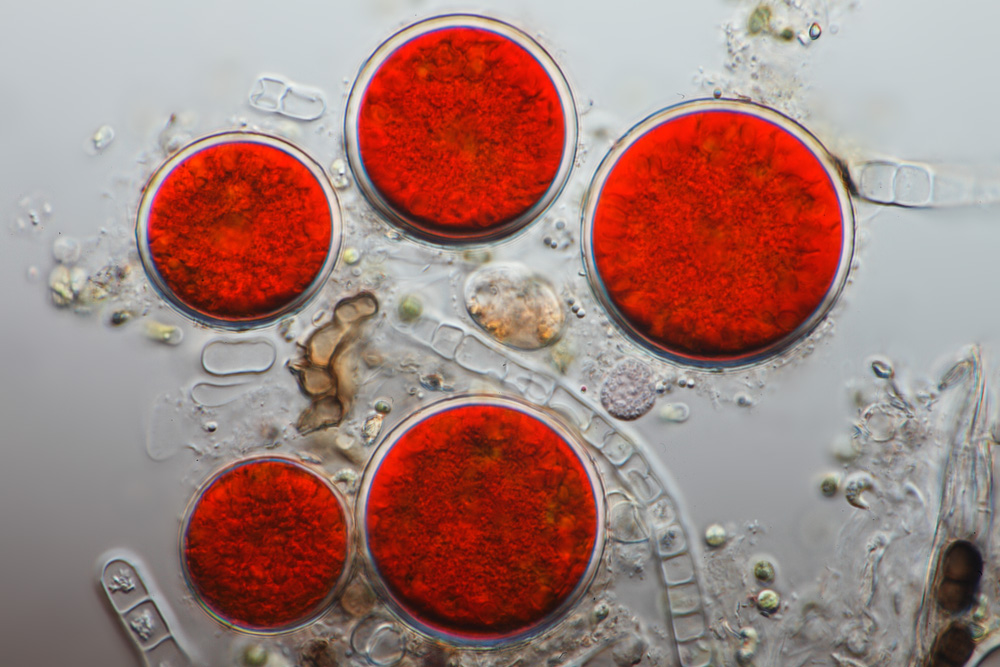
Mechanisms of action
The skin comprises epidermis, dermis and hypodermis, which form the protectively outermost barrier against external environmental stresses such as repeated sun UV ray exposure. UV radiation comprises three types: UVA(Long-wave UV, Passes largely through glass and clothing), UVB(Medium-wave UV, mostly absorbed by the ozone layer, Does not pass through ‘normal’ glass. but does pass through quartz glass, Causes other forms of skin cancer.) and UVC(Short-wave UV, germicidal UV, ionizing radiation at shorter wavelengths, completely absorbed by the ozone layer and atmosphere: hard UV..s very destructive to skin cells). UVC is filtered out by atmospheric ozone for the most part, while both UVA and UVB can cause a biological change in the skin. The overview could be found from the Figure [11] below.
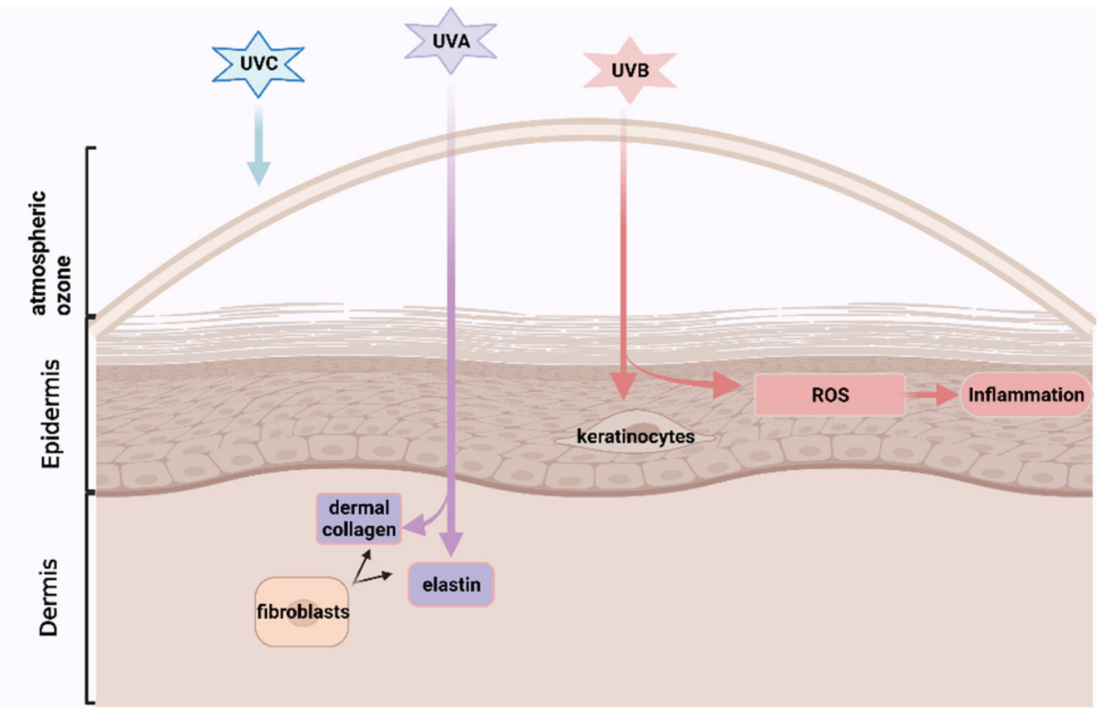
The mechanism of action of Astaxanthin (ASX) involves its multifaceted impact on cellular and molecular processes, particularly in mitigating skin aging.
- Antioxidant and Anti-Inflammatory Properties:
- ASX acts as a potent antioxidant, capturing singlet oxygen radicals in the epidermis and dermis.
- This scavenging ability contributes to the restoration of skin elasticity and a reduction in wrinkle depth.
- Inhibition of Reactive Oxygen Species (ROS):
- Excessive accumulation of ROS from repeated UV exposures and intrinsic aging can lead to inflammatory responses. ASX helps suppress the activation of ROS-producing enzymes and xanthine oxidase (an enzyme found in many species, including humans, and primarily functions in the catabolism of purine nucleic acids) in UV-irradiated cells.
- Regulation of Inflammatory Cytokines and MMPs:
- ASX helps modulate inflammatory cytokines (e.g., IL-1, IL-6, IL-8, TNF-α) (same as resveratrol mentioned before) released due to UV exposure and intrinsic aging.
- This modulation helps inhibit the upregulation of matrix metalloproteinases (MMPs: MMPs, can degrade collagen and elastic fibers, leading to wrinkles and loss of skin elasticity.), including MMP-1, MMP-3, and MMP-9.
- Maintenance of Skin Barrier Integrity:
- ASX supports skin barrier integrity by inhibiting excessive corneocyte desquamation, maintaining the epidermal barrier functions.
- It decreases plasma oxidation-related malondialdehyde (MDA) concentration, contributing to overall skin health.
- DNA Protection and Inflammation Reduction:
- Dietary ASX supplementation reduces DNA oxidative damage biomarkers and lowers concentrations of inflammatory markers. [11]
Grape Seed Extract
Through different and various studies, it was proved that the proanthocyanidin rich grape seed extract provides benefits against many diseases i.e. inflammation, cardiovascular disease, hypertension, diabetes, cancer, peptic ulcer, microbial infections, etc.
The chemical composition of Grape Seed Extract (GSE) is rich and diverse, encompassing various components obtained through specific extraction processes. Grape seeds are manually separated from grapes, air-dried, and ground to a fine powder.The powdered grape seed is macerated in 70% ethanol, filtered, and the filtrate is dried to obtain powdered GSE. Dried grape seeds contain approximately 35% fiber, 29% extractable components, including phenolic compounds, proteins (11%), minerals (3%), and water (7%). [13]
Mechanisms of action
The mechanisms of action of Grape Seed Extract (GSE) are diverse and involve a range of bioactive compounds present in the extract.
- Polyphenols and Flavonoids, anti-oxidant:
- GSE is an abundant source of polyphenols and flavonoids, known for their antioxidant properties and free radical scavenging abilities. The polyphenols in GSE act as effective free radical scavengers, protecting cells from damage caused by reactive oxygen species (ROS).
- Grape seed polyphenols exhibit higher antioxidant activity compared to well-known antioxidants such as vitamin C, vitamin E, and β-carotene.
- Enzymes with Dual Properties for Anti-Inflammatory:
- GSE contains enzymes that not only exhibit antioxidant properties but also catalyze the release of histamine during inflammation and allergies.
- Fatty Acid Composition beneficial for CVD:
- GSE’s fatty acid composition, particularly linoleic acid, is crucial for lipid metabolism.
- Grape seed oil, extracted from the seeds, contains a high amount of unsaturated fatty acids (85-90%), including α-linolenic acid (ω-3) and γ-linolenic acid (ω-6). [13] (These fatty acids are associated with reducing the risk of cardiovascular disease, cancer, hypertension, and autoimmune disorders.)
- The application of grape seed oil is linked to positive effects in reducing arteriosclerosis by lowering total blood cholesterol and LDL cholesterol. [13]
- Dietary Fiber Content:
- Grape seeds and peels contain a significant amount of dietary fiber, contributing to a lower risk of colon cancer, heart disease, diabetes, and obesity.
Enzyme
Serratiopeptidase
Serratiopeptidase is a zinc containing metalloprotease of molecular weight 45–60 kDa. ($1Da = 1.66053906660(50) \times 10^{-27}kg$). It is originally obtained from Serratia marcescens isolated from the intestine of the silkworm Bombyx mori. [14]
The graph below is Serratia marcescens:
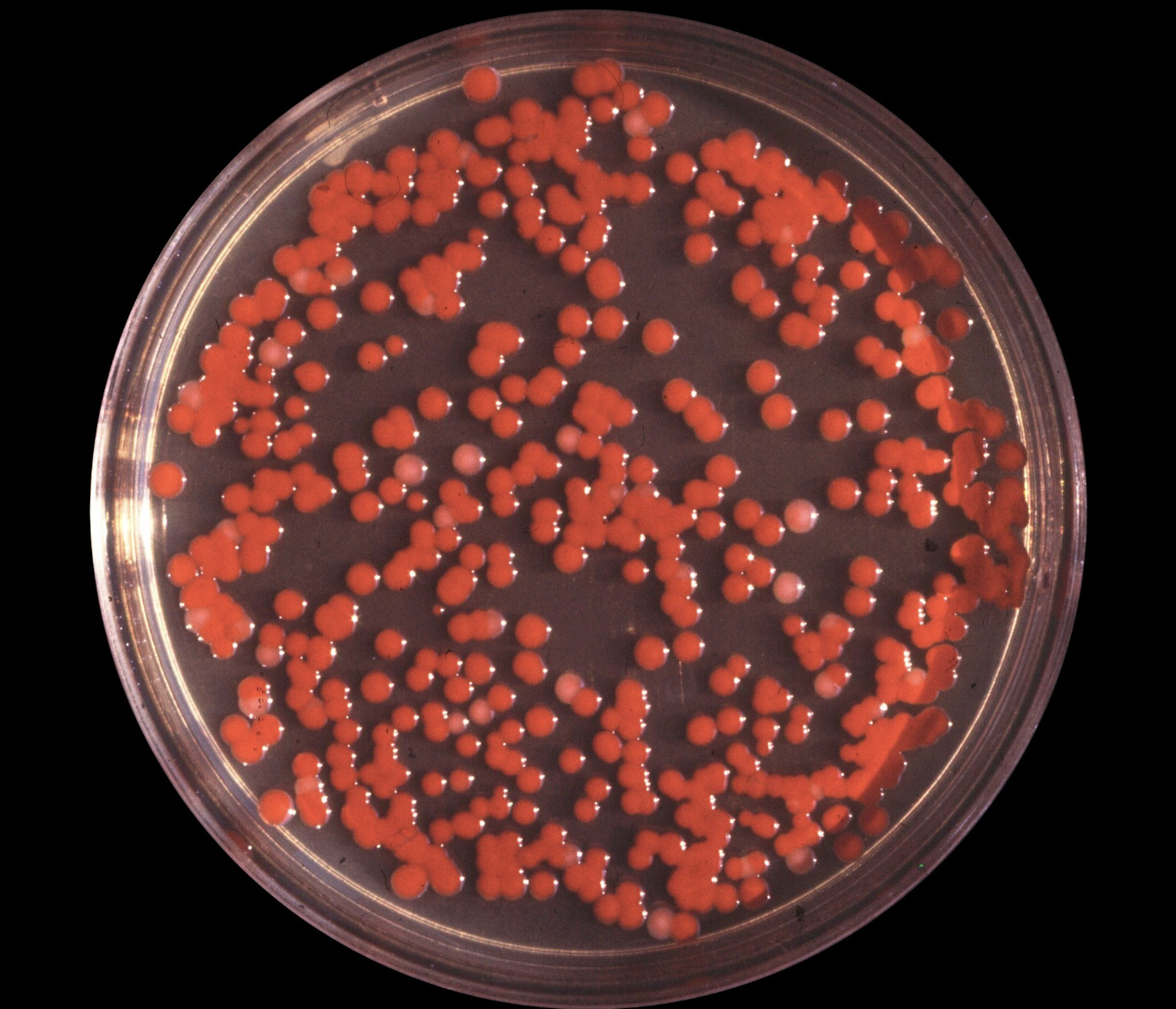
While errapeptase and other proteolytic enzymes break down proteins by hydrolyzing them, breaking the peptide bonds between amino acids (the building blocks of proteins). It is well documented that oral administration of proteolytic enzymes, including serrapeptase, is fully absorbed into the bloodstream and exerts effects throughout the body.
Mechanisms of action
- Reduce pain and inflammation:
- Hydrolyses bradykinin, histamine, and serotonin which helps to decrease pain and swelling and improve microcirculation, which in turn supports the wound healing process. [15]
- Break down non-living protein tisse (fibrin that can clog artness)
- Binds to the macroblobulin inside the blood plasma IT protects itself from immune system.
- Geo target, site specific
- Cardiovascular Disease:
- Plaque: Fat cholesterol, fibre, other protein
- Break down non-living protein tisse (fibrin) -> blood flow
- Ear Nose Throat Infections:
- Geo target inflammation
- Antibiofilm
- The anti-biofilm ability of serratiopeptidase is accredited to its capability of modulating the expression of adhesion molecules and reduces cell surface proteins of bacteria. [14]
Minerals, Vitamins & Other
Vitamin D
Vitamin D is a lipid-soluble prohormone that is vital for the maintenance of bone and muscle health by promoting the absorption and metabolism of calcium and phosphate. [16] In addition to food sources such as fatty fish, eggs, fortified milk and cod liver oil, the human body uses ultraviolet B (UVB) radiation from sunlight to synthesise a significant portion of vitamin D requirements.
The figure below is from Catalyst University, which shows the process of biosynthesis of Vitamin D.
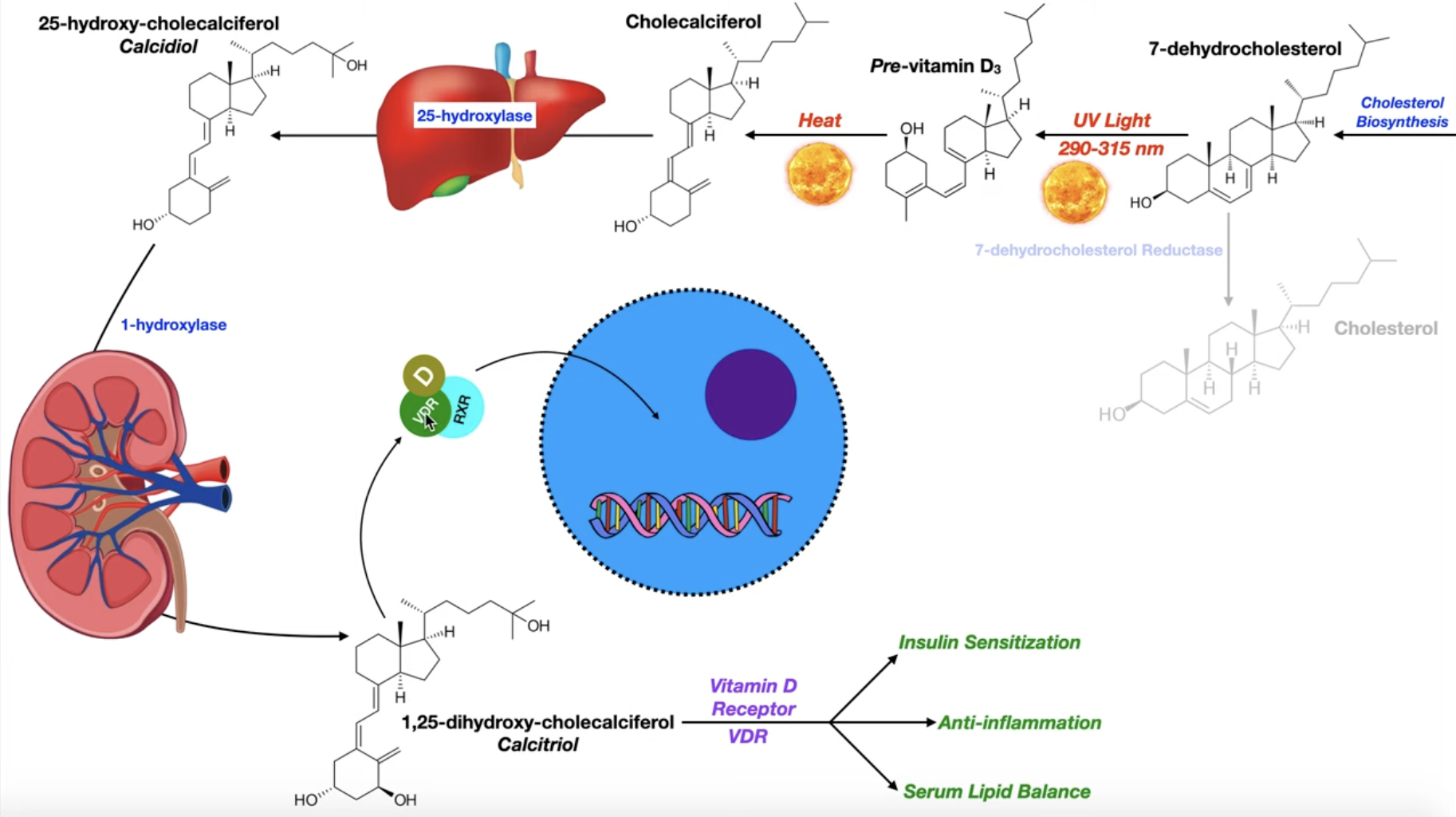
Starting from the up-left of the graph above, the synthesis of vitamin D starts with the oxidation of cholesterol to 7-dehydrocholesterol (7-DHC). (7-dehydrocholesterol is part of the metabolic pathway that controls the synthesis of cholesterol in human cells.) 7-DHC is then transported to the skin and is stored in the cell membranes of keratinocytes and fibroblasts in the epidermis of skin. [16] In the skin, 7-DHC is photolysed by UVB (290–315 nm) to previtamin $D_3$, which is converted to inactive vitamin D (Cholecalciferol) by photolysis-mediated thermo-isomerisation. (What is thermal isomerization?)
To become biologically active, the vitamin D originating from dermal production or dietary sources undergoes a series of enzymatic conversions in the liver and kidney. Vitamin D is transported to the liver by vitamin D binding protein (DBP), together they are transported to the liver where the cytochrome P450 enzyme 25-hydroxylase ([CYP2R1]) adds a hydroxylgroup on carbon 25 to produce a major circulating form of vitamin D (25-(OH)D), aka Calcifediol, this process on the chemical level can be seen from the graph below:
.png)
The Calcifediol then circulates in the bloodstream bound to DBP and it must be further hydroxylated at a different site in the kidney tubules to gain hormonal bioactivity. Hydroxylation at position $1\alpha$ by the mitochondrial cytochrome P450 enzyme 25-hydroxyvitamin D-$1\alpha$-hydroxylase (CYP27B1) of kidney converts Calcifediol to 1α,25-dihydroxyvitamin D (aka calcitriol, is the most active form of Vitamin D, ‘trio’ because it has 3 hydroxl groups), the active form of vitamin D that plays an essential role in mineral homeostasis.
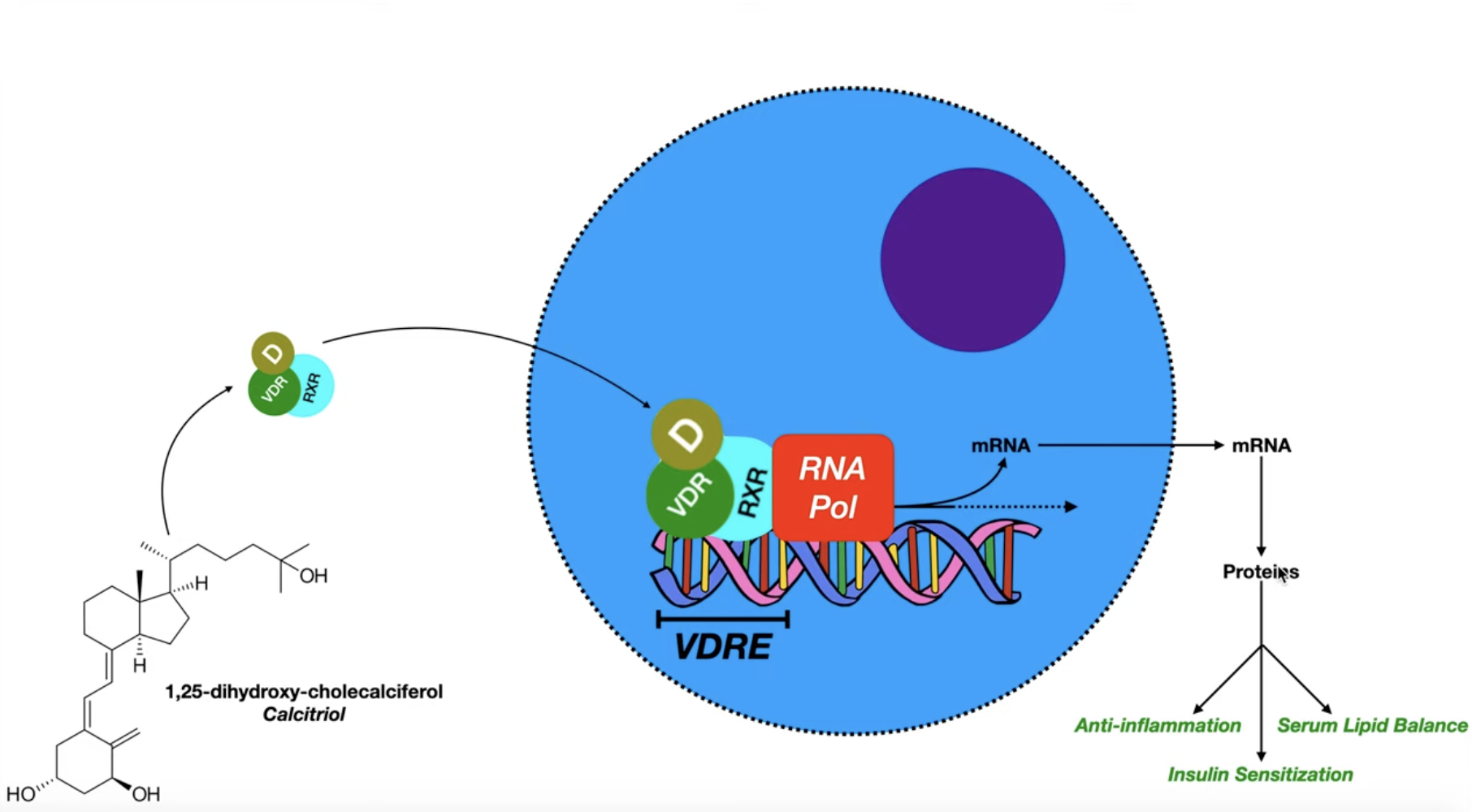
As the graph (from Catalyst University) shown above, the receptor of Calcifediol is not existed in the plasma membrane since it is hydrophobic, instead it is inside nucleus. Calcifediol is bound with Vitamin D receptor (VDR) VDR thens binds to DNA as VDR/VDR homodimers or VDR/RXR heterodimers in order to regulate gene expression. [16]. The dimers subsequently recognise and bind with transcription factor IIB (TFIIB) to a vitamin D response element (VDRE) located in the promoter region of target genes and leads to transcriptional suppression or activation of vitamin D response genes.
Mechanisms of action
- Calcium Absorption & Bone Health::
- The association of low vitamin D and bone diseases such as rickets and osteoporosis is well known. [16]
- Vitamin D is essential for the development and maintenance of healthy bones. It works in conjunction with calcium to support bone mineralization and prevent conditions like rickets in children and osteomalacia in adults.
- Immune System Modulation:
- Vitamin D has immunomodulatory effects, influencing both the innate and adaptive immune systems. It plays a role in the regulation of immune cell functions and the production of antimicrobial peptides.
- The ability to combat infections, in particular, tuberculosis, viral infections and influenza. [17]
- Anti-Inflammatory Properties:
- Vitamin D has anti-inflammatory effects and may help modulate inflammatory responses. e.g. inflammatory bowel disease. [16]
Vitamin K
Vitamin K is a family of structurally similar, fat-soluble vitamers found in foods and marketed as dietary supplements. Vitamin K is important for the function of numerous proteins within the body, such as the coagulation factors. [18]
Vitamin K exists naturally as vitamin K1 (phylloquinone) and vitamin K2 (menaquinone(), MK-4 through MK-10). Vitamin K1 is mainly found in green leafy vegetables as well as olive oil and soyabean oil, whereas vitamin K2 (menaquinone) is found in small amounts in chicken, butter, egg yolks, cheese and fermented soyabeans (better known as natto).
Vitamin K1 is involved in the activation of other clotting factors, including Factors VII, IX, and X. These factors play roles in the coagulation process, preventing excessive bleeding. The absorption rate of vitamin K1 from kale and spinach – foods identified as having a high vitamin K content – are on the order of 4% to 17% regardless of whether raw or cooked. Vitamin K2 is synthesized by bacteria in the human gut. Some of the vitamin K1 from dietary sources is converted into vitamin K2 by these gut bacteria.
Mechanisms of action
- Bone Health:
- Osteoporosis is a leading contributor of fractures worldwide. Vitamin K is required for the gamma-carboxylation of osteocalcin in bone. A broad amount of data seems to indicate substantial potential for supplementary vitamin K. vitamin K1 on its own has already been shown to reduce fractures and cancer in a clinical trial. [19]
- Vascular Calcufications:
- Some vitamin-K dependent proteins are dependent on vitamin-K carboxylation for functionality. [20] Vitamin K acts as a cofactor in the conversion of glutamate into Matrix Gla Protein (MGP). MGP regulate many anticalcification and bone-forming processes in the body, which are dependent on vitamin K in order to be produced. [18]
Magnesium
Electrolytes such as sodium, potassium, calcium, and magnesium are physiologically important due to their integral roles in metabolic and biologic processes. [21] Magnesium (${Mg}^{2+}$) possesses two hydration shells, making its hydrated radius larger than that of other cations (${Na}^+$, $K^+$, and ${Ca}^{2+}$).
The ‘hydrated radius’ is the effective size of the ion when surrounded by water molecules. In the case of magnesium, it has two layers or shells of water molecules around it. Because magnesium has two hydration shells, the presence of these water layers makes the effective size or radius of the hydrated magnesium ion larger compared to other cations (positively charged ions).
Magnesium is an essential mineral which is a cofactor in over 300 enzymatic reactions for protein synthesis such as muscle contraction, nerve function, blood pressure and hormone binding. [22]. Magnesium is required for energy production, oxidative phosphorylation, and glycolysis. It contributes to the structural development of bone and is required for the synthesis of DNA, RNA, and the antioxidant glutathione. Magnesium also plays a role in the active transport of calcium and potassium ions across cell membranes, a process that is important to nerve impulse conduction, muscle contraction, and normal heart rhythm. [23]
As we discussed in the Vitamin D section, vitamin D can’t work without first being converted into a form your body can absorb. The level to which a vitamin or mineral can be absorbed is known as its “bioavailability.” Vitamin D’s bioavailability depends on magnesium. The enzymes (in the liver and kidneys) that enable vitamin D metabolism—converting it into its active form, calcitriol — can’t work without sufficient amounts of magnesium to draw upon.
Early signs of magnesium deficiency include loss of appetite, nausea, vomiting, fatigue, and weakness. Therefore proper intake of magnesium from food or supplements is important. Magnesium supplements are available in a variety of forms. The following information comes from Dr. Jin W. Sung. ‘s YouTube Channel [23].
- Magnesium Citrate:
- Absorption Rate: 30%
- Benefits: Good for constipation.
- Additional Info: More completely absorbed in the gut; considered more bioavailable.
- Magnesium Aspartate:
- Absorption Rate: 42%
- Benefits: Excites neural transmitter activity.
- Additional Info: May enhance neural functions; higher absorption rate.
- Magnesium Glycinate:
- Absorption Rate: 24%
- Benefits: Glycine is a precursor to GABA (inhibitory neurotransmitter), useful for calming effects.
- Additional Info: Supports GABA production; suitable for relaxation.
- Magnesium Chloride:
- Absorption Rate: 20%
- Benefits: Suitable for individuals with low stomach acid issues.
- Additional Info: May be helpful for those with digestive concerns.
- Magnesium Sulfate:
- Absorption Rate: 4%-7%
- Benefits: Limited information provided.
- Additional Info: Slightly lower absorption rate compared to other forms.
- Magnesium Oxide:
- Absorption Rate: 4%
- Benefits: Limited information provided.
- Additional Info: One of the less soluble forms; lower absorption rate.
- Magnesium Theonate:
- Absorption Rate: High
- Benefits: Suggested for sleep.
- Additional Info: May have specific benefits for sleep support.
Omega-3 Fatty Acids
Fish Oil: Fish oil is a dietary supplement derived from the tissues of fatty fish, such as salmon, mackerel, and sardines. It is rich in omega-3 fatty acids, which are essential for various physiological functions in the body.
Omega-3 Fatty Acids: Omega-3 fatty acids are a type of polyunsaturated fat that includes three main types: eicosapentaenoic acid (EPA), docosahexaenoic acid (DHA), and alpha-linolenic acid (ALA). EPA and DHA are commonly found in fish oil, while ALA is present in plant-based sources like flaxseeds and walnuts.
Omega-6 Fatty Acids: Omega-6 fatty acids are another group of polyunsaturated fats that include linoleic acid (LA) and arachidonic acid (AA). These fats are found in various vegetable oils and nuts.
Mechanism of Action:
- Anti-Inflammatory Properties:
- Omega-3s: EPA and DHA from fish oil have anti-inflammatory effects. They can compete with omega-6 fatty acids for the same enzymes, leading to the production of less inflammatory molecules.
- Cardiovascular Health:
- Omega-3s: EPA and DHA contribute to cardiovascular health by reducing triglycerides, lowering blood pressure, and preventing the formation of blood clots. They also have a positive impact on heart rhythm.
- Brain Health:
- Omega-3s: DHA, in particular, is crucial for brain health and development. It makes up a significant portion of the brain’s structure and plays a role in cognitive function.
- Joint Health:
- Omega-3s: Fish oil’s anti-inflammatory properties may benefit joint health, reducing symptoms in conditions like rheumatoid arthritis.
- Immune System Support:
- Omega-3s: EPA and DHA support the immune system by promoting the activity of immune cells.
- Cellular Function:
- Balancing Omega-3 and Omega-6: Maintaining a balance between omega-3 and omega-6 fatty acids is essential. An imbalance, often seen in Western diets, may contribute to chronic inflammation and various health issues.
- Neuroprotective Effects:
- DHA: DHA has neuroprotective effects and is crucial for the development and function of the nervous system.
- ALA Conversion:
- ALA: ALA, found in plant-based sources, can be converted into EPA and DHA in the body, although the conversion rate is relatively low.
Suggest Doses, Summary and Concerns
Supplements come in various forms, and understanding their safe levels is crucial. The following is a brief corresponding supplement suggested dosage based on Observed Safe Level (OSL) of human body.
- NMN (Nicotinamide Mononucleotide):
- NMN products, popular for anti-aging, are available in high doses (e.g., 500 mg).
- Safety is uncertain; rigorous scientific studies are essential for establishing long-term administration levels. [7]
- Astaxanthin:
- This fat-soluble carotenoid is best absorbed with fat-containing meals.
- Dosages range from 4 mg to 12 mg daily, with the ideal amount tailored to age, health, and individual conditions.
- Always follow product label dosages or consult a healthcare professional.
- Serratiopeptidase:
- Recommended dosage is 60 mg/day on an empty stomach in the morning.
- Vitamin K:
- Adequate intake (AI) is suggested at 90 μg/day for women and 120 μg/day for men. [18]
- Vitamin D:
- The recommended daily amount of vitamin D is 400 international units (IU) for children up to age 12 months, 600 IU for people ages 1 to 70 years, and 800 IU for people over 70 years.
- Magnesium:
- The average requirement is 300–400 mg/day, varying based on factors like gender, age, and individual needs.
Understanding the motivation behind exploring supplements is essential. However, it’s equally important to approach these substances with caution. Many supplements listed here are best absorbed when taken with a fatty meal. This enhances their bioavailability, ensuring your body can make the most of their benefits.
Remember, the decision to supplement should not be taken lightly. Always consult with a healthcare professional before introducing any new supplements into your meal. In such cases, seeking guidance from a doctor or checking a reliable drug interaction website (e.g. https://reference.medscape.com/drug-interactionchecker) is advisable to ensure compatibility and prevent any potential adverse effects.
Useful links
- Drug interation: https://reference.medscape.com/drug-interactionchecker
References
[1] Zhang, Li-Xue, Chang-Xing Li, Mohib Ullah Kakar, Muhammad Sajjad Khan, Pei-Feng Wu, Rai Muhammad Amir, Dong-Fang Dai, et al. ‘Resveratrol (RV): A Pharmacological Review and Call for Further Research’. Biomedicine & Pharmacotherapy 143 (November 2021): 112164. https://doi.org/10.1016/j.biopha.2021.112164.
[2] Mattison, Julie A., Mingyi Wang, Michel Bernier, Jing Zhang, Sung-Soo Park, Stuart Maudsley, Steven S. An, et al. ‘Resveratrol Prevents High Fat/Sucrose Diet-Induced Central Arterial Wall Inflammation and Stiffening in Nonhuman Primates’. Cell Metabolism 20, no. 1 (July 2014): 183–90. https://doi.org/10.1016/j.cmet.2014.04.018.
[3] Marques, Francine Z., M. Andrea Markus, and Brian J. Morris. ‘Resveratrol: Cellular Actions of a Potent Natural Chemical That Confers a Diversity of Health Benefits’. The International Journal of Biochemistry & Cell Biology 41, no. 11 (November 2009): 2125–28. https://doi.org/10.1016/j.biocel.2009.06.003.
[4] Y. Bai, H. Yang, G. Zhang, L. Hu, Y. Lei, Y. Qin, Y. Yang, Q. Wang, R. Li, Q. Mao, Inhibitory effects of resveratrol on the adhesion, migration and invasion of human bladder cancer cells, Mol. Med. Rep. 15 (2) (2017) 885–889.
[5] Shade C. The Science Behind NMN-A Stable, Reliable NAD+Activator and Anti-Aging Molecule. Integr Med (Encinitas). 2020 Feb;19(1):12-14. PMID: 32549859; PMCID: PMC7238909.
[6] Schultz MB et al. Why NAD+ Declines during Aging: It’s Destroyed. Cell Metab. 2016 June 14; 23(6): 965–966
[7] Nadeeshani, H., Li, J., Ying, T., Zhang, B., & Lu, J. (2021). Nicotinamide mononucleotide (NMN) as an anti-aging health product – Promises and safety concerns. Journal of Advanced Research. doi:10.1016/j.jare.2021.08.003
[8] Dyer, Andrew R. ‘CoQ10: A Literature Review’ 40, no. 1 (n.d.).
[9] Kędziora-Kornatowska K, Czuczejko J, Motyl J, Szewczyk-Golec K, Kozakiewicz M, Pawluk H, Kędziora J, Błaszczak R, Banach M, Rysz J. Effects of coenzyme Q10 supplementation on activities of selected antioxidative enzymes and lipid peroxidation in hypertensive patients treated with indapamide. A pilot study. Arch Med Sci. 2010 Aug 30;6(4):513-8.
[10] Cordero MD, Cano-García FJ, Alcocer-Gómez E, De Miguel M, Sánchez-Alcázar JA. Oxidative stress correlates with headache symptoms in fibromyalgia: coenzyme Q₁₀ effect on clinical improvement. PLoS One. 2012;7(4):e35677.
[11] Zhou, Xiangyu, Qingming Cao, Caroline Orfila, Jian Zhao, and Lin Zhang. ‘Systematic Review and Meta-Analysis on the Effects of Astaxanthin on Human Skin Ageing’. Nutrients 13, no. 9 (24 August 2021): 2917. https://doi.org/10.3390/nu13092917.
[12] Higuera-Ciapara, I.; Felix-Valenzuela, L.; Goycoolea, F. Astaxanthin: A review of its chemistry and applications. Crit. Rev. Food Sci. Nutr. 2006, 46, 185–196.
[13] Gupta, Madhavi, Sanjay Dey, Daphisha Marbaniang, Paulami Pal, Subhabrata Ray, and Bhaskar Mazumder. ‘Grape Seed Extract: Having a Potential Health Benefits’. Journal of Food Science and Technology 57, no. 4 (April 2020): 1205–15. https://doi.org/10.1007/s13197-019-04113-w.
[14] Jadhav, Swati B., Neha Shah, Ankit Rathi, Vic Rathi, and Abhijit Rathi. ‘Serratiopeptidase: Insights into the Therapeutic Applications’. Biotechnology Reports 28 (December 2020): e00544. https://doi.org/10.1016/j.btre.2020.e00544.
[15] L. Desser, A. Rehberger, E. Kokron, W. Paukovits, Cytokine synthesis in human peripheral blood mononuclear cells after oral administration of polyenzyme preparations, Oncology. 50 (1993) 403–407.
[16] Basit, S. ‘Vitamin D in Health and Disease: A Literature Review’. British Journal of Biomedical Science 70, no. 4 (1 January 2013): 161–72. https://doi.org/10.1080/09674845.2013.11669951.
[17] Ginde AA, Mansbach JM, Camargo CA Jr. Association between serum 25-hydroxyvitamin D level and upper respiratory tract infection in the Third National Health and Nutrition Examination Survey. Arch Intern Med 2009; 169: 384–90.
[18] DiNicolantonio, James J, Jaikrit Bhutani, and James H O’Keefe. ‘The Health Benefits of Vitamin K’. Open Heart 2, no. 1 (October 2015): e000300. https://doi.org/10.1136/openhrt-2015-000300.
[19] Cockayne S, Adamson J, Lanham-New S, et al. Vitamin K and the prevention of fractures: systematic review and meta-analysis of randomized controlled trials. Arch Intern Med 2006;166:1256–61.
[20] Berkner KL. The vitamin K-dependent carboxylase. Annu Rev Nutr 2005;25:127–49.
[21] L.L. Yu, W.C. Davis, Y. Nuevo Ordonez, S.E. Long, Fast and accurate determination of K, Ca, and Mg in human serum by sector field ICP-MS, Anal. Bioanal. Chem. 405 (27) (2013) 8761–8768.
[22] Author Dr. Jin W. Sung. “Magnesium—-Comprehensive Guide. Forms of magnesium, benefits, dosages, impact on Vitamin D.” YouTube, uploaded by Dr. Jin W. Sung, June 2023,https://www.youtube.com/watch?v=Z4ohSzChgII&ab_channel=Dr.JinW.Sung
[23] Rude RK. Magnesium. In: Ross AC, Caballero B, Cousins RJ, Tucker KL, Ziegler TR, eds. Modern Nutrition in Health and Disease. 11th ed. Baltimore, Mass: Lippincott Williams & Wilkins; 2012:159-75.
[24] Simopoulos, Ap. ‘Omega-3 Fatty Acids in Health and Disease and in Growth and Development’. The American Journal of Clinical Nutrition 54, no. 3 (September 1991): 438–63. https://doi.org/10.1093/ajcn/54.3.438.
Enjoy Reading This Article?
Here are some more articles you might like to read next: